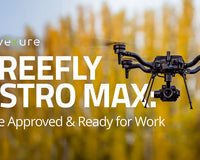The Importance of Altitude in SAR Operations
Three Functions of Remote Sensing
Detection
Recognition
Identification
The Drone SAR Altitude Guide
SkyBound Rescuer, in collaboration with DJI, has developed the Drone SAR Altitude Guide to assist search drone pilots in determining the optimal flying altitude for finding missing persons.
Using this free guide is really very simple. It takes into account variables such as the body position of the missing person (laying down or standing up), planned flying altitude, and camera angle (top-down or slanted).
Best DJI Drones for SAR Operations

DJI Matrice 350 RTK with Zenmuse H20N
- Flight Time: Extended flight time for extended search and mapping operations
- Telemetry:
- Transmission Range - Up to 15 km (9.3 miles) (FCC) or 8 km (5 miles) (CE);
- Frequency Bands - 2.4 GHz and 5.8 GHz
- Battery: Intelligent Flight Battery (TB60)
- Battery Charge Time: Approximately 60 minutes
- Battery Life: Up to 400 charging cycles
- Operating Temperatures: -20°C to 50°C (-4°F to 122°F)
- Autonomy Features:
- Advanced Obstacle Avoidance: The Matrice 300 RTK is equipped with advanced sensors and computer vision systems to detect and avoid obstacles in its flight path. It can intelligently navigate around obstacles, ensuring safe and efficient SAR operations even in complex environments.
- Precision Flight Modes: The drone offers a range of precision flight modes, including Point of Interest (POI), Waypoint, and ActiveTrack, enabling precise and automated flight paths for accurate search and tracking of missing persons.
- AI-powered Object Detection: The Matrice 300 RTK incorporates AI algorithms for object detection, enabling the drone to automatically identify potential search targets, such as humans or vehicles, in real-time. This feature enhances the efficiency and effectiveness of SAR operations.

DJI Matrice 30T
- Flight Time: Extended flight time for extended search and thermal imaging operations
- Telemetry: Transmission Range - Up to 15 km (9.3 miles) (FCC) or 8 km (5 miles) (CE); Frequency Bands - 2.4 GHz and 5.8 GHz
- Battery: Intelligent Flight Battery (TB60)
- Operating Temperatures: -20°C to 50°C (-4°F to 122°F)
- Autonomy Features:
- Intelligent Flight Modes: The Matrice 30T offers a variety of intelligent flight modes, including ActiveTrack, Spotlight, and Hyperlapse, enabling the drone to autonomously follow and capture the subject of interest, track moving targets, and capture stunning aerial imagery during SAR missions.
- Smart Return to Home: With its advanced GPS capabilities, the drone can automatically return to its takeoff point or the pilot's location in case of low battery, signal loss, or on command. This feature ensures the safe retrieval of the drone and minimizes the risk of losing valuable data during SAR operations.
- Flight Planning and Waypoint Navigation: The drone supports advanced flight planning software that allows operators to create precise flight paths and predefined waypoints. This enables efficient and systematic coverage of search areas, optimizing search and rescue efforts.

DJI Mavic 3 Thermal
- Flight Time: Up to 46 minutes
Telemetry: Transmission Range - Up to 15 km (9.3 miles) (FCC) or 8 km (5 miles) (CE); Frequency Bands - 2.4 GHz and 5.8 GHz
Battery: Intelligent Flight Battery (M3T)
-
Operating Temperatures: -10°C to 40°C (14°F to 104°F)
Autonomy Features: - Advanced Flight Assistance Systems: The Mavic 3 Thermal incorporates advanced flight assistance systems, including obstacle sensors and intelligent tracking modes. These features enhance flight safety and enable the drone to navigate complex environments, avoiding obstacles and ensuring smooth and reliable SAR missions.
Advanced Thermal Imaging Capabilities: With its high-resolution thermal camera, the drone provides detailed thermal imagery for improved situational awareness. It can detect heat signatures, identify potential targets, and capture thermal data for analysis, enhancing the effectiveness of search and rescue efforts.
ActiveTrack 4.0: The Mavic 3 Thermal offers ActiveTrack 4.0 for autonomous subject tracking. These features allow operators to document search areas effectively and track subjects of interest during SAR operations.

DJI Mavic 3 Enterprise
- Flight Time: Up to 46 minutes
- Telemetry:
- Transmission Range - Up to 15 km (9.3 miles) (FCC) or 8 km (5 miles) (CE);
- Frequency Bands - 2.4 GHz and 5.8 GHz
- Battery: Intelligent Flight Battery (M3E)
- Battery Charge Time: Approximately 120 minutes
- Battery Life: Up to 200 charging cycles
- Operating Temperatures: -10°C to 40°C (14°F to 104°F)
- Autonomy Features:
- Advanced Flight Modes: The Mavic 3 Enterprise offers advanced flight modes, such as ActiveTrack 4.0, Spotlight, and Hyperlapse, enabling autonomous tracking, precise hovering, and creative aerial shots. These features enhance operational efficiency and flexibility during SAR missions.
- Modular Accessories and Payloads: The drone supports various modular accessories, including a spotlight, loudspeaker, and beacon, expanding its capabilities for search and rescue operations. These accessories enhance visibility, communication, and identification of search targets, improving overall mission effectiveness.
- OcuSync 3.0 Transmission System: The Mavic 3 Enterprise features OcuSync 3.0, a reliable and long-range transmission system that provides stable and high-quality video transmission even in challenging environments. This ensures seamless communication and real-time situational awareness for SAR teams.
If you have any further questions or need assistance with SAR drones, please don't hesitate to reach out to our team of subject matter experts. Open a Live Chat with our team or Email us. With over 10 years of experience and expertise in the industry, we can help you make informed buying decisions and provide necessary training to help you build a successful UAS program.










